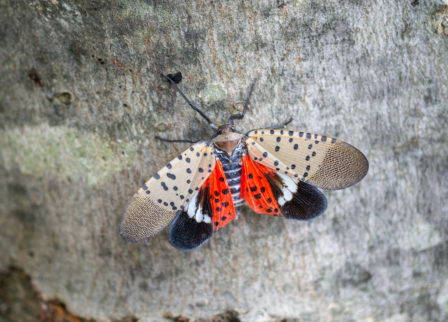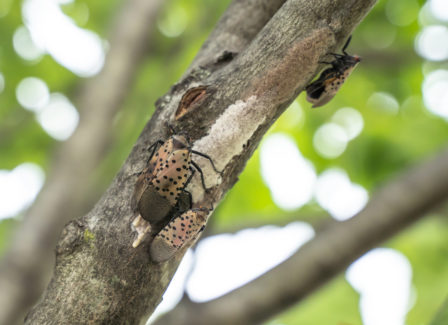Do you have Spotted Lanternflies on your property? If not, consider yourself lucky! While this invasive pest may be easy on the eyes, they are problematic to Pennsylvania’s residents and economy.
The latest information shows that the Spotted Lanternfly could impact Pennsylvania’s economy to the tune of $324 million annually! We want to share with you, information about this invasive pest and HOW we can help you MANAGE and STOP the spread of the Spotted Lanternfly!
What Does The Spotted Lanternfly Look Like?

The Spotted Lanternfly is black with white spots and around a 1/4 inch in total length. As they continue to grow, they will keep feeding on herbaceous plant material and retain their black and white appearance until July – August time. This is when they will start to show a bright red on their body. This is the fourth instar and the last step before becoming adults. At this stage, they will feed on more types of plant material. Their preferred tree species is the ailanthus or the tree of heaven. While they prefer this tree, they also are commonly found feeding on Maples, Walnuts, Birch, Cherry, and Willow trees. In late July – early August, the adults emerge with black-spotted wings and red accents inside their wings. This makes them very easy to identify.
The Problem!
Once the Spotted Lanternfly is an adult, its size is approximately 1 inch in length. As adults, they can now fly and with their increased mobility comes increased problems for homeowners and the general public alike. It is common to see swarms of adults into the thousands feeding on one tree or in the same area. In the fall, the adults will begin to lay eggs. Each egg mass has between 30 – 50 eggs in it! Spotted Lanternflies will lay egg masses on almost any smooth, hard surface. Egg masses are commonly found on the trees they are feeding on and on light poles, children’s playsets, firewood, and even underneath cars and trucks. Egg masses laid on trucks and rail cars are a large cause of the quick spread of the spotted lanternfly across the commonwealth. As well as people unknowingly moving firewood with eggs from place to place.
Additionally, as the Spotted lanternfly feeds, it produces a sticky excretion called honeydew. This is the result of ingesting the sap from the trees.
This sugary substance causes a variety of issues.

1) It is sticky
When it falls onto cars, patios, and outdoor seating areas, it makes quite a mess. Also, it is hard to clean off.
2) Attracts unwanted pests
This sticky, sugary substance will attract other unwanted pests such as ants, bees, and wasps. If the stickiness and unwanted visitors weren’t enough, the honeydew often turns into sooty mold. A greyish-black fungus that can cover your driveway and/or your patios. As the sugars break down, this can cause a very unpleasant smell.
3)Stress on trees
The feeding that large swarms of spotted lanternflies are known to do causes extra stress on your trees. This can lead to decreased health and, in some cases, mortality of a heavily stressed tree.
Here at Tomlinson Bomberger, our Spotted Lanternfly program’s primary goal is to lower the population of this pest as much as possible. We want to improve your time spent outdoors so that you can enjoy your family and landscape!


